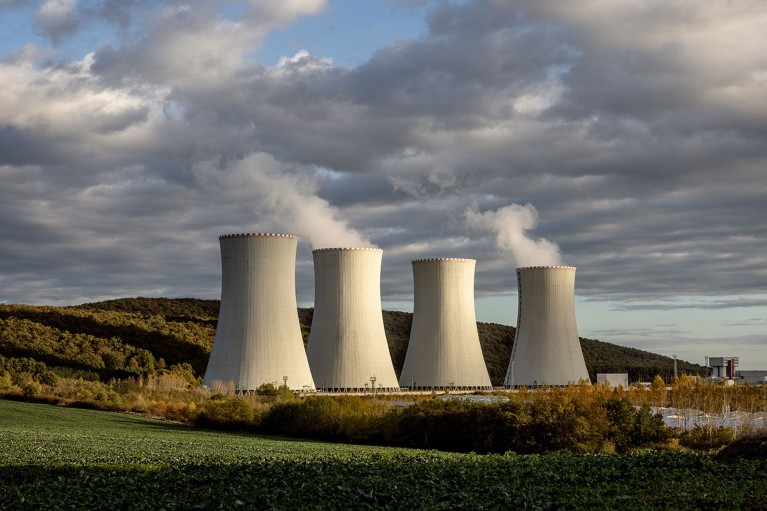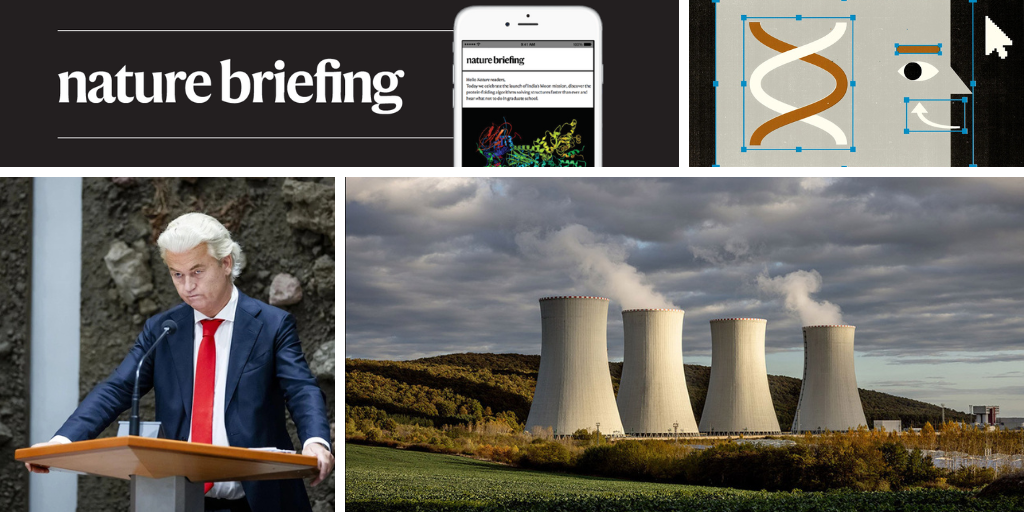Hello Nature readers, would you like to get this Briefing in your inbox free every day? Sign up here.

Small modular reactors are designed to be cheaper, safer and faster to build than those used in conventional nuclear power plants, such as this one in Mochovce, Slovakia.Credit: Janos Kummer/Getty
Tech giants Amazon, Google and Microsoft have all recently announced plans to support nuclear power generation as part of efforts to become carbon-neutral. Amazon and Google’s plans involve companies that are pioneering the design of ‘small modular reactors’, while Microsoft will support the restart of a decommissioned 835-megawatt reactor in Pennsylvania. These plans come as the energy requirement of data centres supporting artificial intelligence (AI) skyrocket. Nature talked to nuclear-energy researchers to explore the significance and possible implications of these big-tech investments.
Virus-like elements in mammalian genomes kick-start blood production during pregnancy by triggering an immune response. Researchers analyzed blood samples from pregnant people and found that activity of ‘jumping’ DNA elements called retrotransposons was higher in their blood stem cells compared with people who weren’t pregnant. Activation of these sequences, which were previously thought of as ‘junk DNA’, triggers immune sensors that encourage haematopoietic stem cells to differentiate into blood cells, making the additional blood required for growing a baby. The team are planning a larger clinical study to investigate what it is about pregnancy that activates the retrotransposons.
A surge in far-right parties entering governments across Europe is raising concerns for science. Policy experts warn that these parties typically show no interest in research and innovation, leaving scientists vulnerable to budget cuts. In the Netherlands, researchers are bracing for €1 billion (US$1.1 billion) in cuts to the university and research budget under a coalition government including the anti-Islam Party for Freedom. The coalition also wants to limit the intake of international students and implement rules that would require universities to apply for permission to teach courses in English, which could trigger an exodus of foreign academics who don’t want to, or can’t, teach in Dutch.
Therapy using digital avatars could reduce the distress of hearing voices for people with psychosis. Results from a clinical trial show that the people undergoing the therapy also heard voices less frequently. Patients work with a therapist to build an avatar that represents a voice they hear. The therapist then speaks both as themselves and as the avatar using a voice changer during treatment sessions. “I was hearing up to 30 or 40 abusive voices a day and it brought it down to about four or five,” says Nick, who took part in the trial. “I felt like I was taking back control of my life again.”
Reference: Nature Medicine paper

As part of the therapy, patients can personalise their avatar’s voice (left) and facial characteristics (right) to best match it to one of the voices they hear.
Features & opinion
As early as the mid-1990s, scientists suggested editing molecules of RNA as a treatment for certain diseases, but at the time, they lacked the tools to do so. Around thirty years later, those tools are at our disposal. Editing RNA instead of DNA has several advantages. It’s a process that cells perform naturally, it doesn’t risk permanently altering a person’s genes and it doesn’t introduce bacterial enzymes to human cells as CRISPR-Cas9 gene therapies do. The field of RNA editing may be in its infancy, but pharma companies are already testing its use in some types of eye disease and cancer.
They say a picture is worth a thousand words. That’s doubly true in research, where the right illustration can clarify complex scientific principles or methods – not to mention, save space in length-constrained funding applications and publications. Graphic designers, scientific and medical illustrators, and journal art directors shared their tips and resources for creating polished visuals. “People make snap judgements based on visuals, and if they don’t look good, they can steer someone away from a paper that otherwise they might like to read,” says Kelly Krause, creative director for the Nature family of journals.
Markets for biodiversity credits, which private companies can buy to fund activities that improve biodiversity such as forest restoration, could succeed where carbon-credit markets have not, argue four members of the International Advisory Panel on Biodiversity Credits. Buying these credits could boost a company’s profile, fund remediation of their activities or enhance biodiversity in their supply chains. However, for biodiversity-credit markets to thrive, governments must develop clear rules and the importance of Indigenous and local knowledge and leadership in conservation and restoration projects must be recognized.
Today I’m looking around for someone to hug. Studies have linked hugs to protection from the common cold and reduced stress, with five to ten seconds being the optimal length. But if you don’t have a hugging partner, never fear. Even self-hugs seem to offer stress-relieving benefits.
Send a virtual hug, or any feedback you have on this newsletter, to [email protected].
Thanks for reading,
Jacob Smith, associate editor, Nature Briefing
Want more? Sign up to our other free Nature Briefing newsletters:
• Nature Briefing: Careers — insights, advice and award-winning journalism to help you optimize your working life
• Nature Briefing: Microbiology — the most abundant living entities on our planet — microorganisms — and the role they play in health, the environment and food systems
• Nature Briefing: Anthropocene — climate change, biodiversity, sustainability and geoengineering
• Nature Briefing: AI & Robotics — 100% written by humans, of course
• Nature Briefing: Cancer — a weekly newsletter written with cancer researchers in mind
• Nature Briefing: Translational Research — covers biotechnology, drug discovery and pharma


